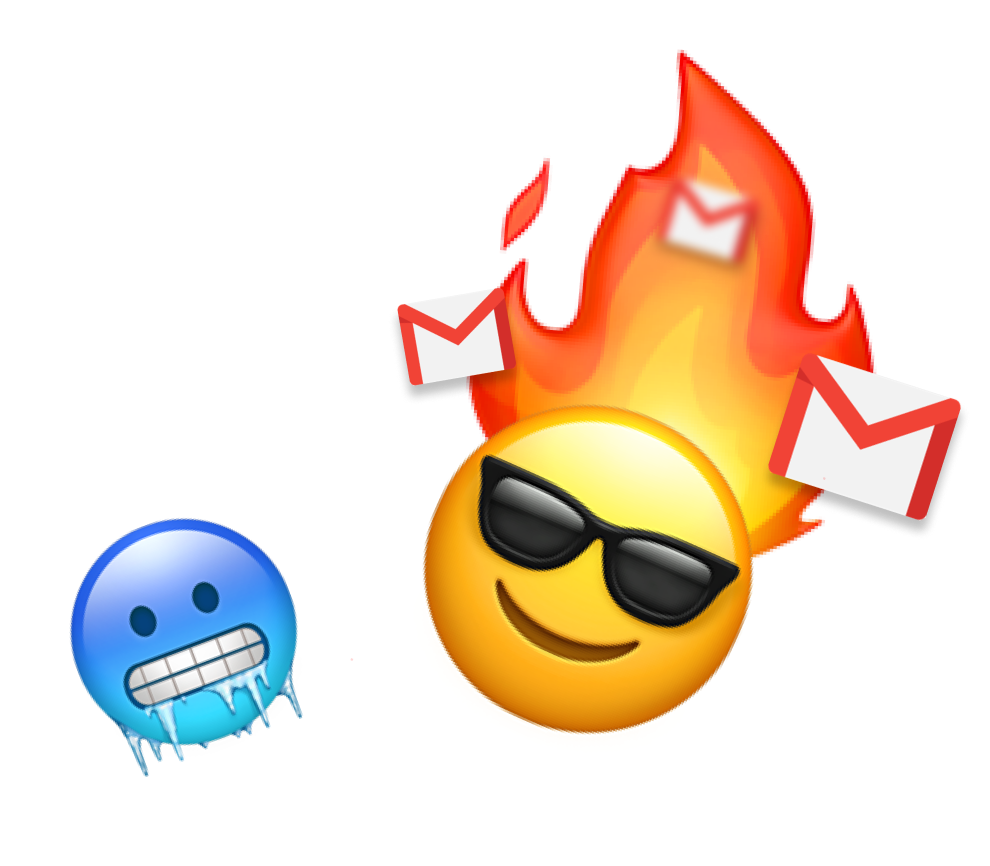Not sure what cold email is? Or want to learn more about this outreach strategy? In this quick guide, we’ll explain how cold emailing works, and how this channel can help you generate leads, find partnerships, and drive more revenue.
Cold emailing is a marketing tactic used by thousands of companies of all sizes to spark conversations with their target audience.
This lead generation channel is budget-friendly (unlike paid ads), and easy-to-implement (unlike SEO).
In this guide, we’ll explain what cold emails are, why this tactic is so powerful, and how to create cold outreach campaigns.
We’ll also share our favorite tools, along with some best practices to take your cold email strategy from “meh” to “wow”.
Here’s a quick overview:
- What is a cold email?
- Why should you send cold emails?
- Cold email use cases
- Is it legal to send cold emails?
- Key elements of a successful cold email
- How to write a cold email that gets replies
- Cold email best practices
- Top 3 cold email tools for efficient outreach
- 5 high-ROI cold email templates
Sounds good? Then let’s dive in.
What is a cold email?
A cold email is like knocking on someone’s door without any prior introduction—but in the digital world. Unlike warm emails, which are sent to people you’ve already interacted with, a cold email is a message sent to someone you’ve never communicated with before. The goal? To start a conversation, build a relationship, or even make a sale.
While cold emails are unsolicited, they are far from spam. The key difference is that cold emails are carefully targeted and personalized to specific individuals or businesses that could benefit from your product, service, or offer. Unlike spam, which is sent indiscriminately to large lists, cold emails focus on creating meaningful dialogue and delivering value.
Why should you send cold emails?
Cold emails are an effective, cheap, and scalable way to reach new prospects, generate leads, and grow your business. These messages offer a direct line of communication to people who can help you achieve your goals.
Here are some of the benefits of cold emailing:
- Affordable: Unlike paid ads or other marketing channels, cold emails require minimal investment. You can start for free with Mailmeteor.
- Cost-effective: According to Litmus, the average ROI of a cold email is $36 for every $1 spent.
- Scalable: Cold emails can be automated, allowing you to reach thousands of potential clients in a (very) short time.
- Targeted: Cold emails allow for highly personalized messaging. This increases your chances of getting a response.
- Measurable: You can track open rates, click-through rates, and response rates to measure the effectiveness of your campaigns.
Companies of all sizes are using cold emails to scale their business. For example, Justin McGill leveraged this outreach strategy to grow LeadFuze’s revenue to $30k/month in 12 months.
Cold email use cases
Cold emails are versatile. You can use them to generate new business opportunities, grow your network, find a job, and connect with influencers, donors, or potential partners. Here are some common cold email use cases:
1. Lead generation
Need to find new customers? Cold emails are a simple, yet effective way to reach out to potential buyers, pitch your product or service, and move them into your sales pipeline. You can generate high-quality leads. With minimal investment.
2. Sales outreach
Sales teams often use cold emails to connect with prospects and schedule sales meetings. Cold outreach helps them capture attention, spark interest, and turn leads into deals to drive more revenue.
3. Networking
Cold emails aren’t just for sales. They can also help you build your network and open the door to valuable business connections. You can use cold emailing to connect with industry experts, collaborate on projects, or form partnerships.
4. Job hunting
Looking for new career opportunities? Cold emails can help you get your resume in front of potential recruiters. Instead of waiting for job postings, you can be proactive, start conversations, and demonstrate your interest.
5. Event invitations
Cold emails can also be used to promote events, webinars, or product launches. Send personalized invitations to targeted prospects to boost attendance, making sure that your event reaches the right audience.
6. Media outreach
Lastly, cold emailing is also a simple way to reach out to influencers, bloggers, copywriters, and journalists to get coverage for your products or services. This channel can help raise awareness and build your brand presence.
Is it legal to send cold emails?
Cold emails are unsolicited emails. But they’re different from spam. Mostly because they’re targeted and personalized.
In most countries, including Europe, Canada, and the United States, cold outreach is a perfectly legal channel.
In the United States, for example, the CAN-SPAM Act allow business to send cold emails, as long as they abide by these rules:
- The sender identity is clear (no misleading subject lines or “from” addresses).
- There is a way to opt out of your emails (like an unsubscribe link).
- A physical postal address is included in the email.
Similarly, in Europe, the General Data Protection Regulation (GDPR) doesn’t forbid you from sending cold emails. However, there are strict guidelines:
- You must have a legitimate interest to contact the recipient, such as offering relevant services or products.
- You can only collect information that directly relates to the purpose of your outreach.
- You have to store their personal data securely and provide a clear opt-out option.
To sum up, cold emailing is safe and legal in most countries. As long as you follow anti-spam laws and avoid misleading communications.
How to create a cold email that gets replies
At Mailmeteor, we’ve sent 10,000+ cold email campaigns. Our top emails have 60%+ open rates and 20%+ reply rates. Here’s the simple 10-step process that we’ve been using to create stellar cold email campaigns.
1. Build your contact list
To send a cold email campaign, you need to know who’s your target audience. Are you planning to reach out to S&P 500 companies in the Tech industry? Or to solopreneurs in the Health niche?
Here’s how to pinpoint your ideal customer, and find their contact details:
- Identify your ideal prospects: Start by defining your target audience. Who are the decision-makers that will benefit from your offer?
- Leverage LinkedIn and other sources: Use LinkedIn, industry directories, or tools like Hunter.io to find relevant leads.
- Verify email addresses: Use email finders and email extractor tools to build a clean email list and avoid bounces (Mailmeteor does that for free).
To import your contact list in Mailmeteor:
- Sign up to Mailmeteor (it’s free!)
- Click Contacts.
- Select New list.
- Name your list.
- Click Import contacts.
- Import a CSV file or copy and paste email addresses.
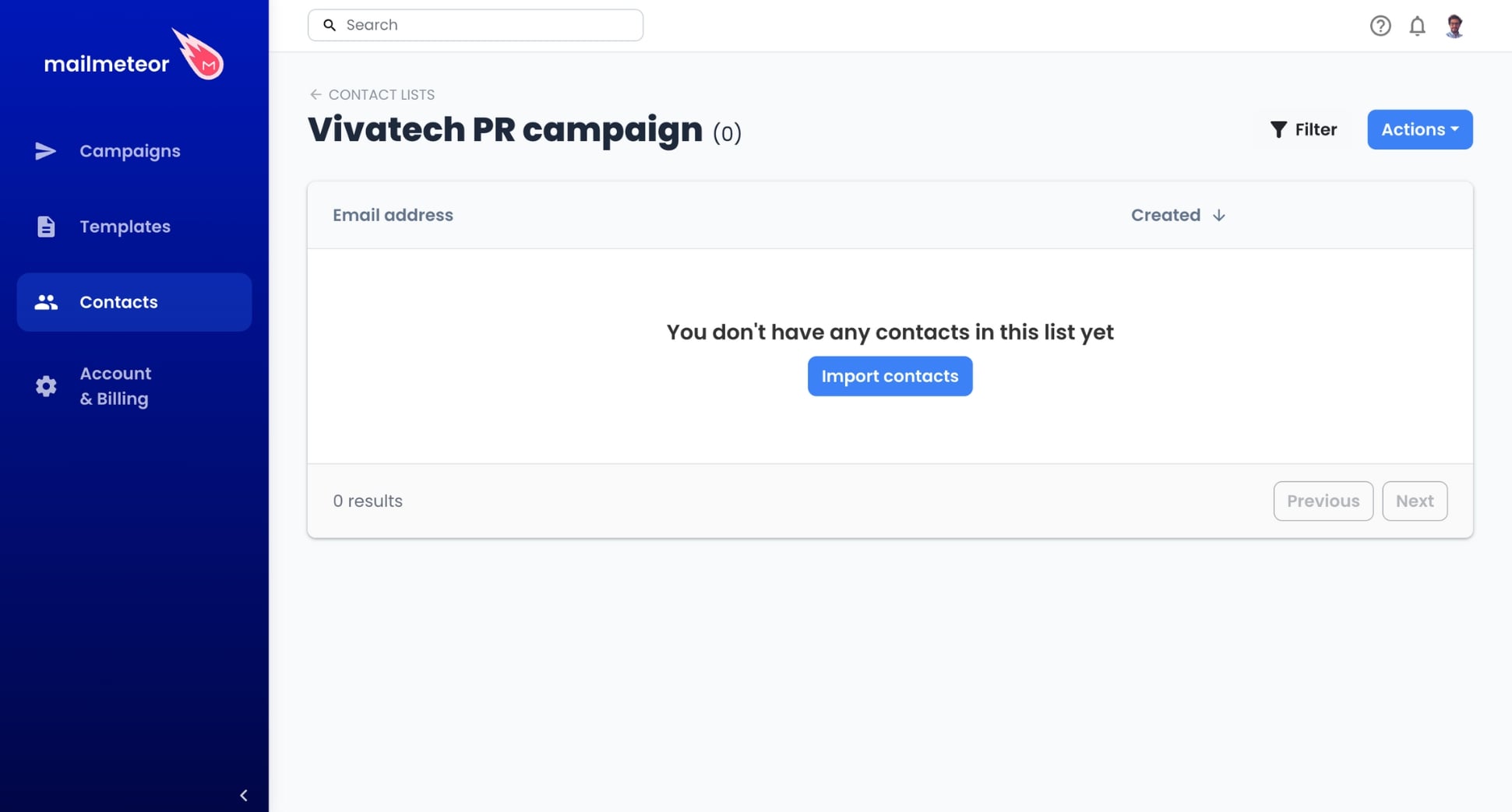
While many cold email softwares are available, this guide will walk you through how to do it with Mailmeteor, since you’re here on our site.
2. Craft your subject line
The subject line is the first thing people will see. It needs to spark their curiosity, and leave them wanting more. If your cold email subject line falls short, your recipients most likely will ignore your email. Without even opening it.
A great subject line should be:
- Concise: According to a study from Marketo, the ideal email subject line length is about 41 characters.
- Personalized: Show that you’ve done your homework. Mention something relevant to them to grab their attention.
- Enticing: Ask an intriguing question, or create a curiosity gap by giving them just enough information to make them want to know more.
To start working on your cold email template:
- Go to the Mailmeteor Dashboard.
- Click New campaign.
- Add your subject line.

Example: What if you could reduce [Pain Point] by 50%?
3. Personalize your message
The average American worker receives 121 business-related emails a day. So a generic email simply won’t cut it. To stand out in crowded inboxes and make your recipients feel special, personalization is key.
To make your cold email personalized:
- Use their name: Forget “Dear Sir”, or “Hey there”. Instead, always address the recipient by their name.
- Do your research: Mention relevant details like recent company news, industry trends, or challenges they’re facing.
- Reference their company or role: Make them feel special. Show them that you’ve done your research.
To customize the body of your cold email:
- Click Select recipients (in the To field).
- Import recipients from a contact list, a spreadsheet, or a CSV file.
- Click Insert variable and select a variable.

Example: “I noticed that [Recipient’s Company] is expanding into [New Market]. Here’s how we can help you increase your sales by 35% in this area.”
4. Introduce your value proposition
Your value proposition is the heart of your cold email. This is where you show the recipient what’s in it for them. Why should they care about your offer? A strong value proposition explains the benefit you bring and how it solves their problem.
To create a compelling value proposition:
- Highlight the benefit: Focus on the outcome they can expect, like saving time, increasing revenue, or improving efficiency.
- Be specific: Use numbers or data points to back up your claim. Concrete results are more convincing than vague promises.
- Show how you solve their pain point: Tailor your message to address a specific challenge or need your recipient is facing.
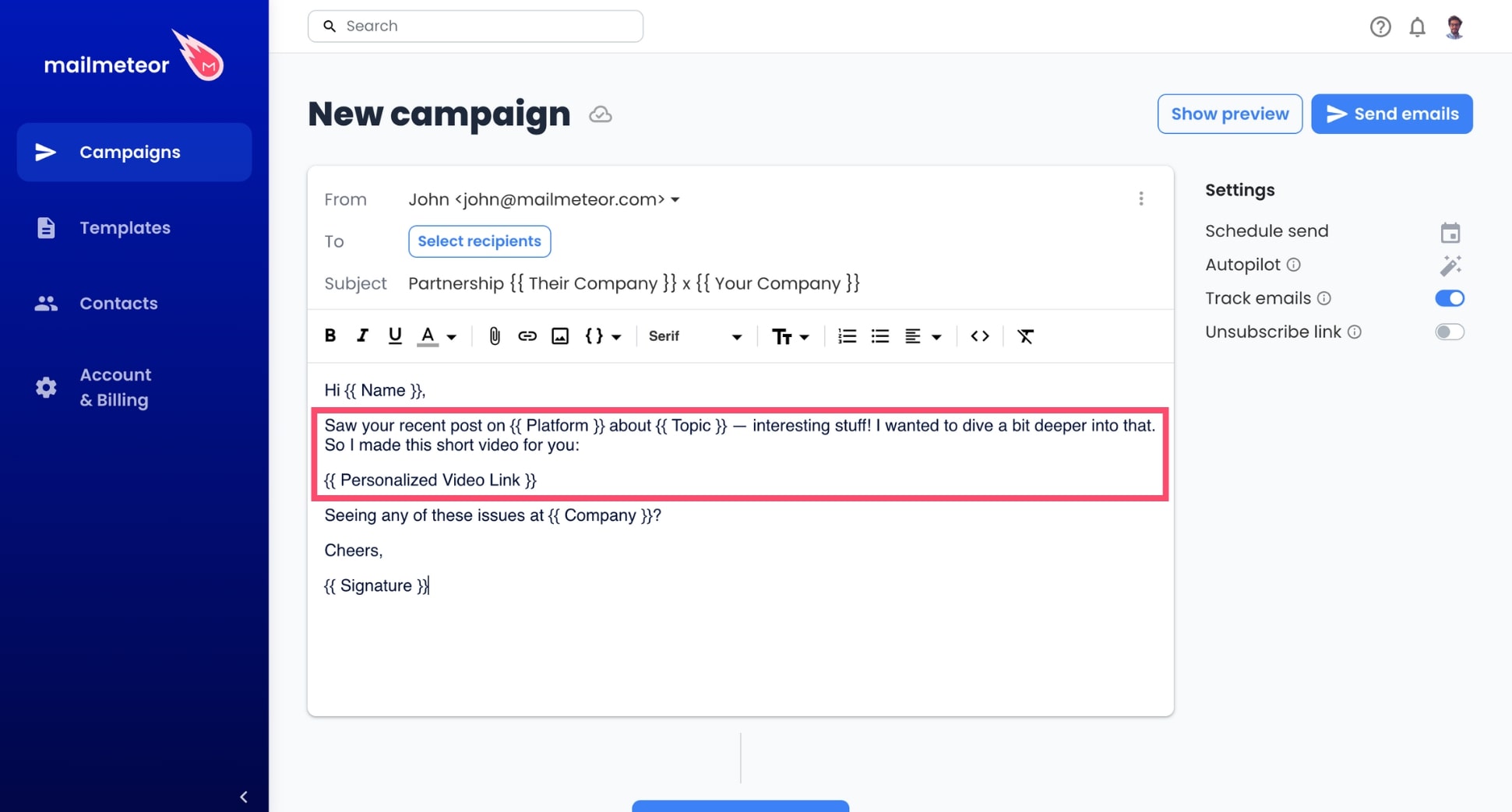
Example: “Our tool has helped companies like [Company] increase their lead conversions by 57% in just 3 months. I believe we can help you achieve similar results.”
5. Include a clear call-to-action
Ultimately, the goal of your cold email is to prompt your recipient to take a specific action. Do you want them to book a call? Reply with feedback? Or check out your website? Always end your message with a clear and actionable CTA.
To create an effective CTA:
- Make it clear: Avoid vague requests. Tell them exactly what you’d like them to do.
- Make it easy: Remove any friction from the process. Include a link, suggest a time for a call, or offer to provide more information.
- Create urgency: If possible, add a sense of urgency to encourage quick action (e.g., limited availability, an upcoming deadline, etc.).
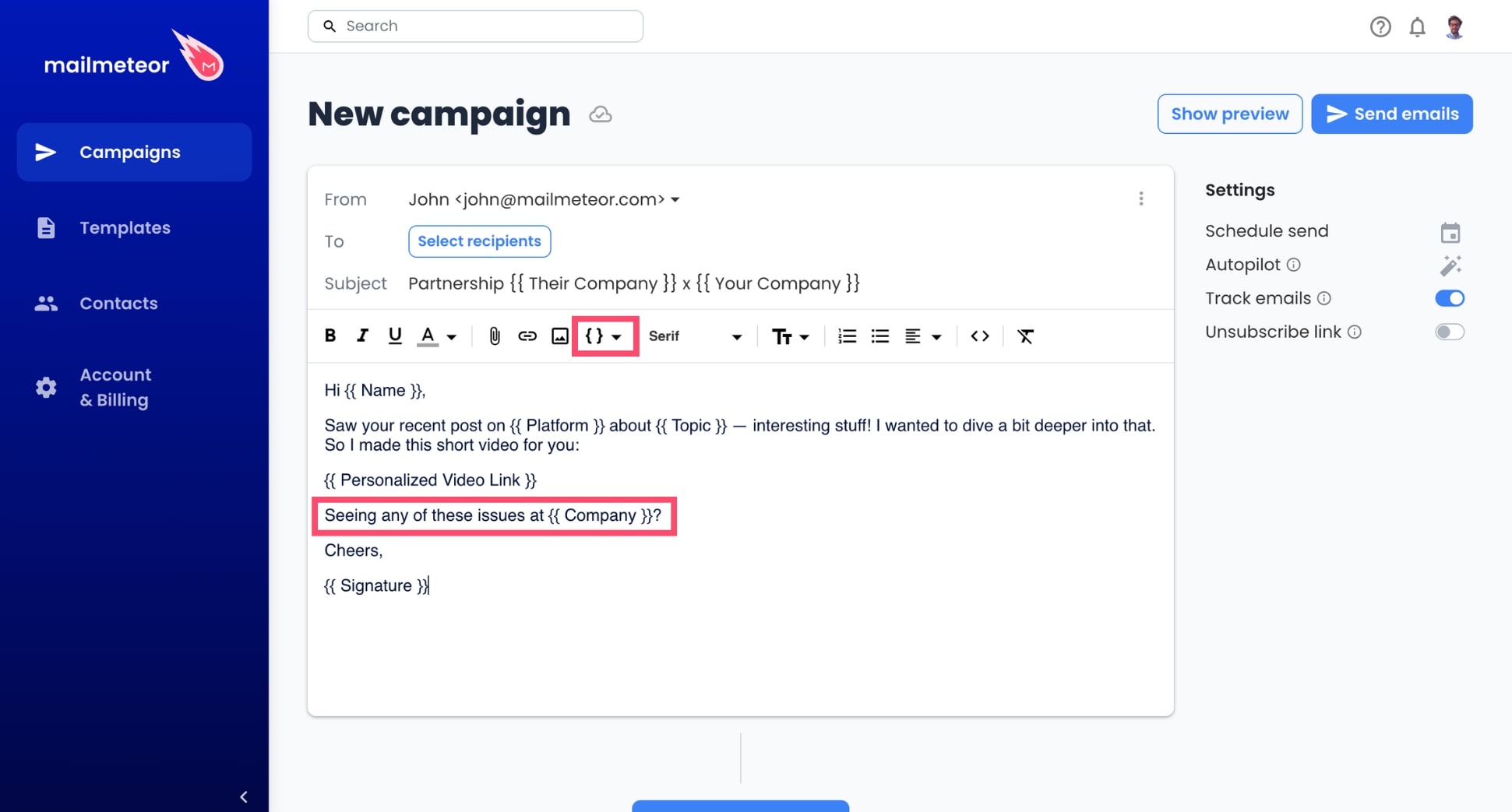
Example: “Would you be open to a 10-minute call next week to discuss how we can help [Company Name] streamline your processes? Feel free to pick a time that works for you here [link].”
6. Add your signature
Your cold email signature is more than just a formality. It’s the last thing your recipient will see. A professional signature helps build credibility and shows your recipient and how they can reach you.
To craft an effective email signature:
- Keep it simple: Avoid complex HTML signatures, and don’t include too many links and images. These can hurt your deliverability.
- Make it mobile-friendly: With over 41% of emails opened on mobile devices, your signature needs to look good on small screens. .
- Use visual hierarchy: Start with key information, like your name. End with less important details, like your social media profiles.
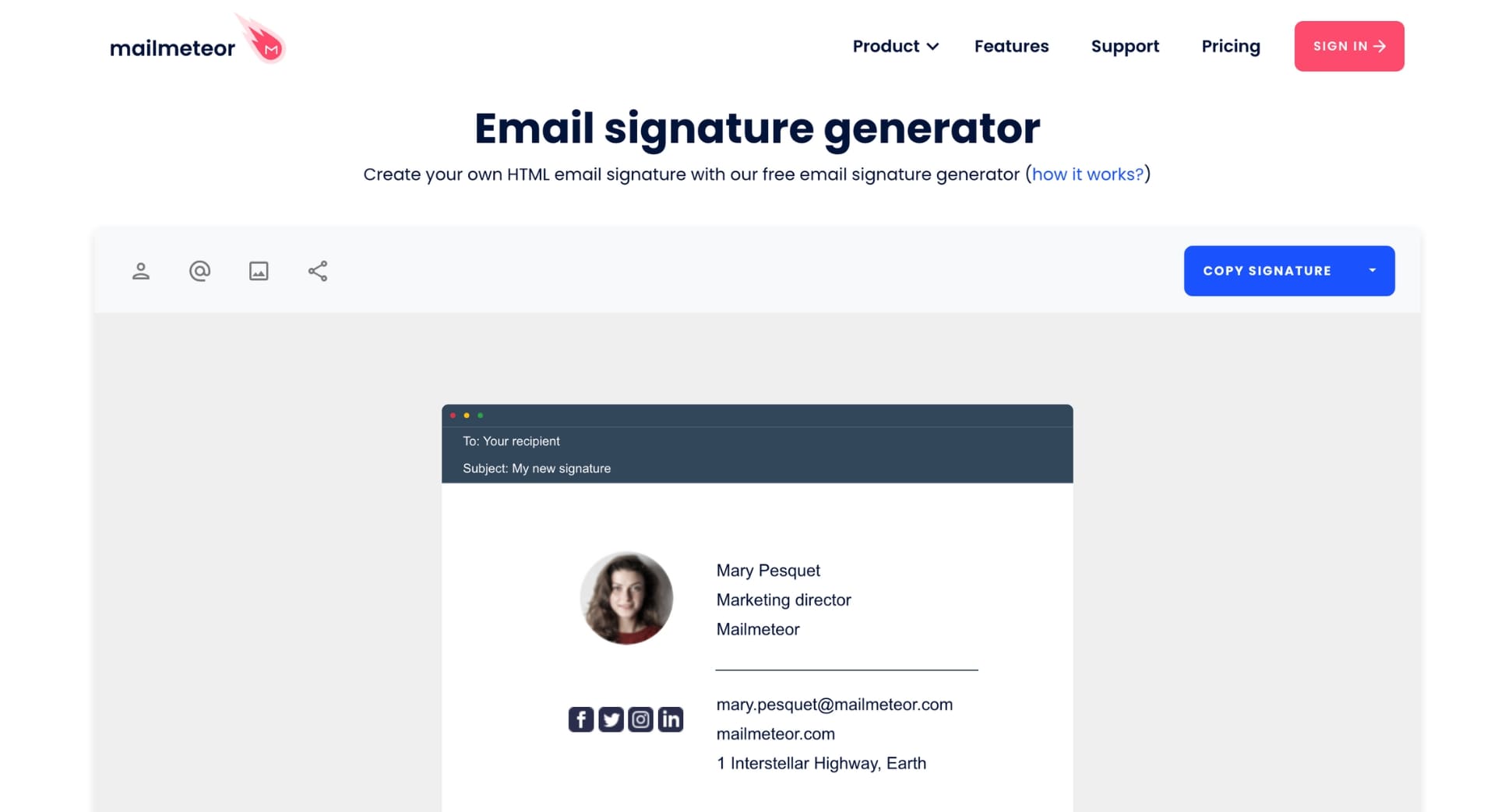
Example:
John Doe Sales Manager at [Company Name] [LinkedIn Profile] | [Company Website]
7. Preview before sending
Before you hit “Send”, take a moment to preview your cold email. Make sure that everything looks clean, professional, and error-free. Verify that your personalized variables are correctly populated.
To avoid common cold email mistakes:
- Double-check personalization: Make sure that all name and company variables are filled in correctly.
- Proofread your content: Review your email for any spelling or grammar errors..
- View on mobile: Make sure that your emails look great on both desktop and mobile devices. Test them with different email clients.
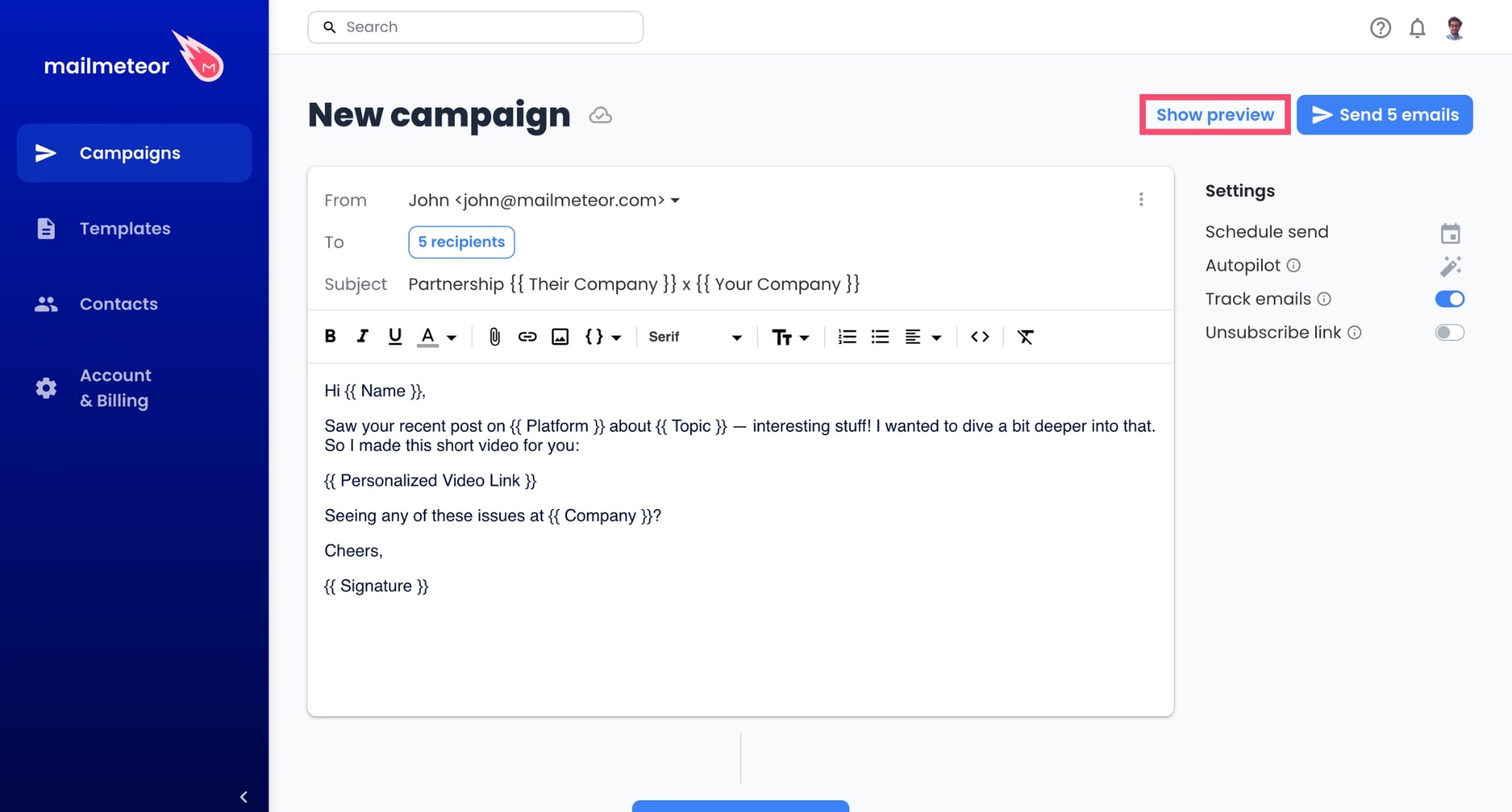
8. Schedule follow-ups
A single email isn’t always enough to get a response. That’s why follow-ups are critical. But don’t worry. Your follow-ups don’t need to be pushy or salesy. Instead, gently remind your recipient and provide additional value. To create effective cold outreach follow-ups:
- Space them out: Allow 3-7 days between follow-ups so you don’t overwhelm your recipient.
- Add new value: Share additional insights, solutions, or resources in your follow-up emails.
- Keep it short: Follow-ups should be concise and to the point. Make sure to reference your initial email.

Example: “Just following up to see if you had a chance to review my previous email. I’d be happy to chat more about how we can support [Company Name] in achieving [Benefit].”
9. Optimize for deliverability
To make sure that your cold emails will land in inboxes (and not in spam folders), you need to optimize the deliverability of your campaign, and improve your sender reputation.
Here’s how to improve the deliverability of your cold emails:
- Verify email addresses: Use email verification tools to remove inactive or fake email addresses (with our BounceShield, this is done automatically).
- Avoid spammy language: Stay clear of spam words, or excessive punctuation (!!!). Use our free spam checker to improve your emails.
- Delay sending: Don’t send all your cold emails at once. Instead, add a small delay between each email to mimic human sending patterns.

10. Monitor your performance
Your work isn’t over yet. Once your cold email campaign is live, you can use cold email platforms such as Mailmeteor, Saleshandy, or Lemlist to track your emails in real-time. This helps understand what’s working and where you can improve.
Track these cold email statistics:
- Open rate: How many recipients opened your email? A low open rate may signal that your subject line needs improvement.
- Reply rate: Measure how many people responded to your email. Low reply rates might indicate that your message or CTA isn’t compelling enough.
- Bounce rate: Keep an eye on how many emails bounce back, as this may suggest issues with your contact list.
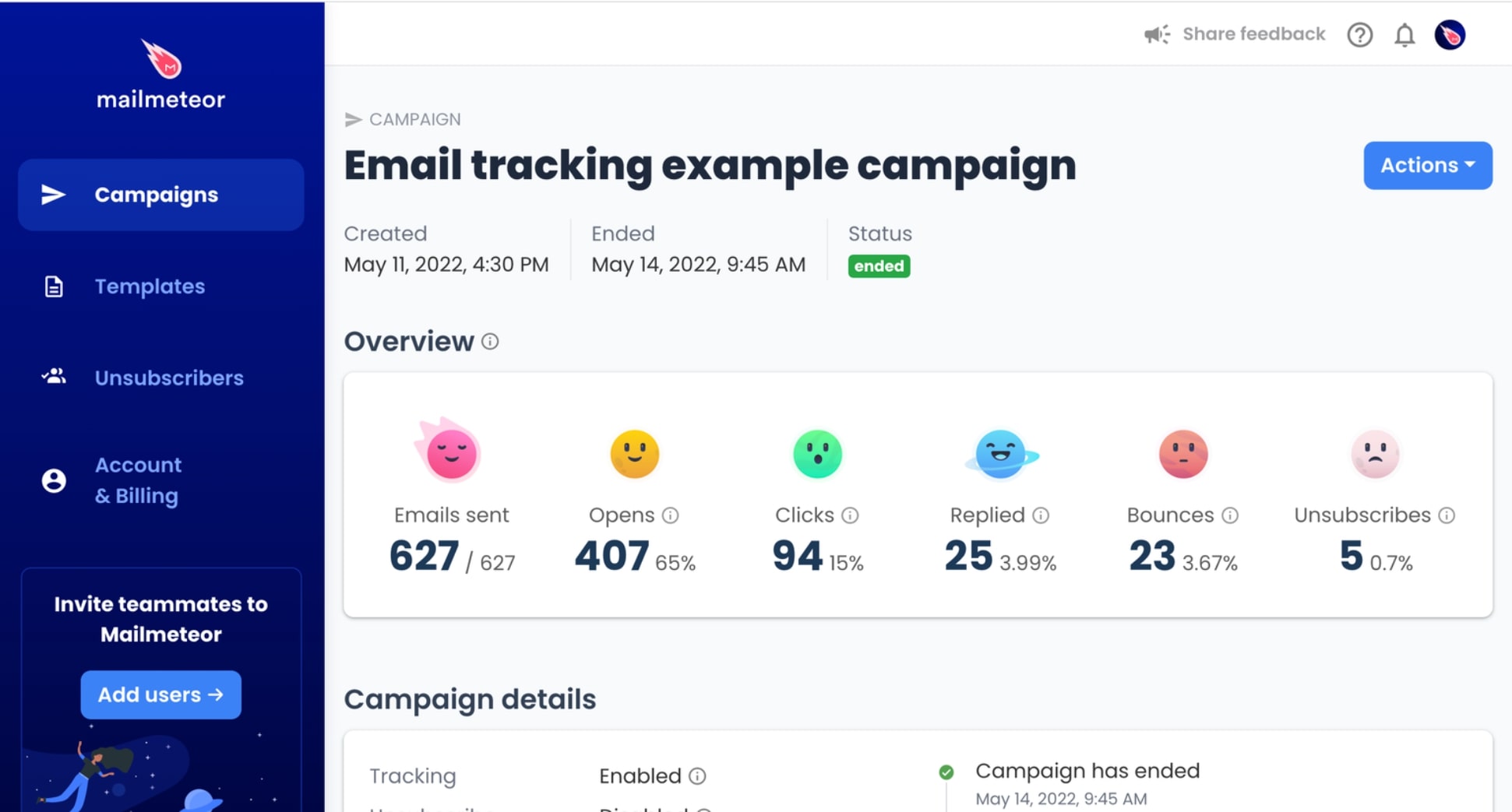
Cold email best practices
Sending cold emails is simple. Just write an email to a potential customer, and press send. But getting people to open, read, and reply to your emails is far from easy. Here are some best practices to help you create cold emails that get results:
- Personalize your emails: Research your recipient and their company. Tailor your message to their specific needs or pain points.
- Keep it concise: Respect the recipient’s time by getting to the point quickly. Aim for 2-3 short paragraphs.
- Optimize for mobile: Use a responsive cold email template, a readable font size, and preview your emails on different devices before sending.
- Follow-up strategically: Don’t be afraid to follow-up 3-5 times. Provide new value in each follow-up and space them out.
- Test and iterate: Run A/B tests and track open rates, reply rates, and conversion rates to continuously refine your approach based on data.
- Comply with regulations: Include an unsubscribe option, avoid misleading subject lines, and clearly identify yourself and your company.
- Time your emails right: Consider the recipient’s time zone. Use scheduling features to reach them at the best time. Avoid weekends and holidays.
- Proofread meticulously: Check for spelling and grammar errors. Make sure that all personalized fields are correct. Be authentic: Write in a conversational tone, avoid jargon, and show genuine interest in the recipient.
- Use social proof: Mention well-known clients, relevant awards, and mutual connections if applicable.
- Optimize deliverability: Use a reputable email service provider and maintain a clean email list.
Top 3 cold email tools for efficient outreach
There are dozens of cold email platforms on the market. But only a handful of them are worth their price tags. Most cold email tools are (very) expensive. Or lack key features, such as email verification, follow-ups, and tracking.
Here are our top 3 picks for cold email tools:
1. Mailmeteor
Rating: 4.9/5 on the Google Workspace Marketplace
Mailmeteor is an intuitive cold email platform designed to help anyone create high-ROI email campaigns in minutes.
This app is used by 5M+ happy professionals worldwide, including small businesses and big companies like Spotify, Pinterest, and Huber.
You can use this platform to scale your outreach and send up to 2,000 personalized cold emails a day. No technical skills required.
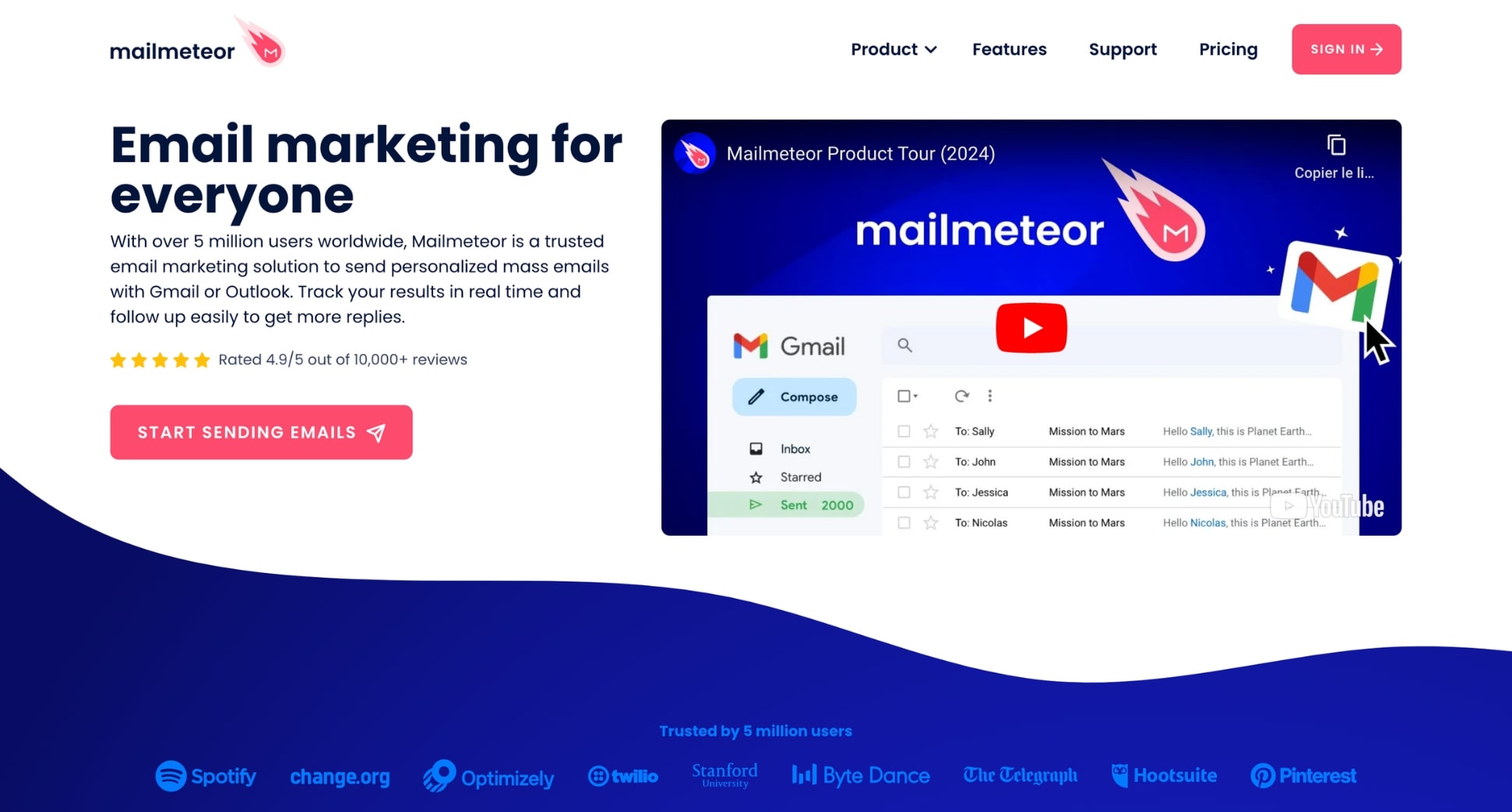
Key features:
- Automated follow-ups and email sequences
- Customizable cold email templates
- Unsubscribers management
- Embed videos and images
- Built-in email verification
- Live email tracking
- CRM integrations
- Email aliases
Ideal for: Businesses of all sizes that are looking for a simple, intuitive and affordable tool to create stellar cold email campaigns.
2. Lemlist
Rating: 4.5/5 on G2
Lemlist is a cold outreach platform that was created in 2018 by Guillaume Moubeche, a French entrepreneur.
Today, this tool is used by 37,000+ sales reps to find leads on LinkedIn, and connect with them via email or direct messages.
Lemlist is quite expensive. But this platform offers interesting features, such as personalized images, and an email warm-up tool.

Key features:
- Email tracking
- LinkedIn cold outreach
- Personalized images and videos
- Drip campaigns and automated follow-ups
- Customized email templates
- Email warm-up tool
Ideal for: Fast-growing companies with a big budget that wants to reach their prospects via multiple channels (cold emails, Linkedin outreach, cold calling).
3. Woodpecker
Rating: 4.2/5 on G2
Woodpecker is a reliable cold email service that lets you segment your audience, personalize your emails, and track them in real-time.
This app was created in 2015 and is used by 15,000 sales professionals to spark conversations and drive revenue.
Woodpecker has powerful features. Including a built-in AI that can detect the interest level of your leads, and sort replies to help you focus on the most promising opportunities.

Key features:
- Inbox rotation
- Cold email templates
- Condition-based campaigns
- Email validation and bounce detection
- Randomized sending frequency
- Email warm-up tool
- CRM integration
Ideal for: Sales teams and agencies that want to automate their cold outreach strategy and improve their email deliverability.
5 high-ROI cold email templates
Need some help to get started? Here are 5 battle-tested cold email templates that you can use to get more responses. Make sure to personalize them with detailed information about your recipients.
1. The “Mutual Connection” template
Hey [Name],
Hope you’re doing well! [Mutual Connection] and I were chatting the other day and your name popped up when we talked about [Topic]. Thought it’d be a good idea for us to connect.
I’m [Your Name], working in [Your Expertise]. I’ve got some ideas that might align nicely with what you’re doing at [Their Company], and I’d love to share them with you.
Got time this week for a quick call? Would love to dive in and see where we can help each other out.
Cheers,
[Signature]
2. The “Free Offer” template
Hi [Name],
[Your Name] from [Your Company] here. I’ve been watching what you guys are doing at [Company] in [Field]—super cool stuff!
However, I ran a quick audit and saw 3 things that are hurting your [Performance]. I can show you exactly how to fix this.
Up for a quick screen share next [Date] at [Time] to see what I mean?
Cheers,
[Your Signature]
3. The “Pain Point” template
Hi [First Name],
I see many companies like [Their Company] facing [Specific Pain Point].
At [Your Company], we’ve helped 100+ [Ideal Customer Profile] overcome this by [Brief Explanation Of Your Solution].
I’d love to share a few ideas that could help [Their Company] achieve [Desired Result] in less than [Period].
Would you like to explore this topic further?
Best,
[Your Signature]
4. The “Broken Link” template
Hi [Name],
Hope you’re doing great :)
Just noticed that this link [Broken Link] on your page [Page Link] is no longer working.
I’ve created a similar resource that you can link to instead: [Your Link]. Hope this helps!
Let me know if you change the link.
Cheers,
[Your Signature]
5. The “PR Outreach” template
Hello [First Name],
I’m reaching out on behalf of [Name of the Expert], [Job Title] at [Company], who specializes in [Area of Expertise].
We’ve been following your work at [Media], and I believe [Name of the Expert]’s insights would be a great fit for your upcoming stories.
Here are a few timely topics they can speak to:
- [Topic 1]
- [Topic 2]
- [Topic 3]
If any of these topics align with your current editorial needs, I’d be happy to set up a quick interview or provide additional information at your convenience.
Have a good day!
[Your Signature]
The bottom line
Cold emails are a simple, yet powerful way to scale your outreach, grow your business, and drive revenue.
This marketing channel lets you connect with hundreds of prospects at once, while making each of them feel unique.
For us (and many of our customers), cold emailing has been a complete game-changer with an impressive 36:1 ROI.
In this guide, we’ve provided key insights to help you understand cold emailing and how to effectively implement this strategy.
What’s next? Sign up to Mailmeteor (it’s free!) and create your first cold email campaign today.
Our free plan lets you send up to 50 personalized emails a day. You can also track your emails in real-time, schedule follow-ups, and more.
Happy sending 💌
FAQs – Cold email outreach
Is cold emailing considered spam?
Cold emails are unsolicited. But they’re not spam. Because they’re targeted, personalized, and designed to provide value to the recipient. Not trick them or steal their personal data. However, make sure to include a clear opt-out option and to comply with legal guidelines, such as the CAN-SPAM Act or GDPR.
What are the drawbacks of sending cold emails?
While cold emailing can be an effective strategy, there are a few potential drawbacks:
- Low response rates: The average response rate of a cold email is around 8%. Though top-performing campaigns can reach 20-30%.
- Reputation risk: Sending too many unsolicited emails without proper targeting or personalization can harm your deliverability.
- Time-consuming: Building targeted contact lists and personalizing your emails can be (very) time-intensive without automation tools.
- Legal concerns: If not done correctly, cold emailing can violate anti-spam laws, leading to penalties, or blacklisting.
What is the success rate of cold emails?
Generally, open rates for cold emails range from 15% to 30%, while reply rates can fall between 1% and 10%. But campaigns with personalized content and targeted lists, can achieve higher success rates. For example, at Mailmeteor, our top cold email campaigns have seen 60%+ open rates and 20%+ reply rates.
How long should a cold email be?
A cold email should be brief and to the point. Research shows that the ideal length is around 125 words. Your goal is to capture the recipient’s attention and quickly communicate your value proposition. Use short paragraphs and line breaks to improve readability and get more replies.
